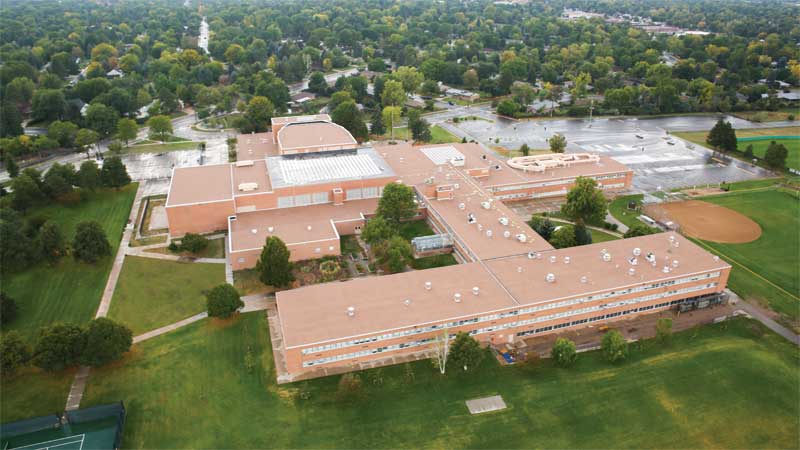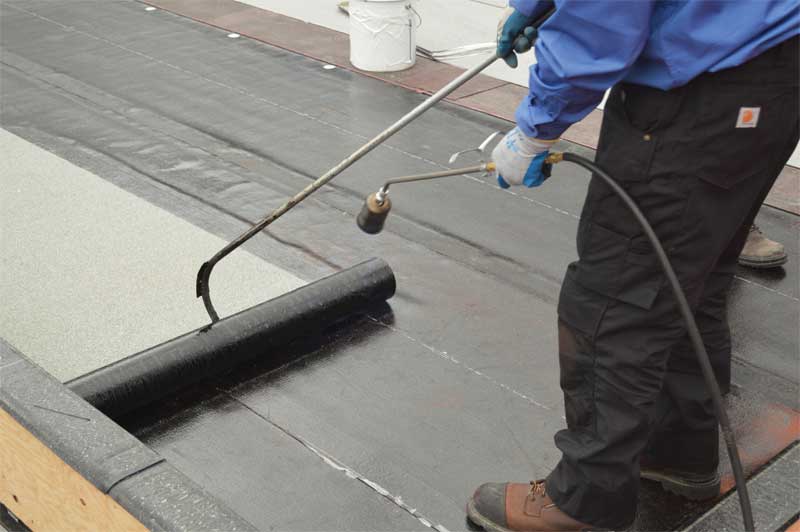| THOMAS JEFFERSON HIGH SCHOOL |
 An example of a mop-applied built-up roofing system is the Thomas Jefferson High School in Denver, Colo. After years of enduring hot sun, freezing snow storms, and heavy wind and hail, the school’s roof was suffering from leaks. It required immediate attention before it reached a critical stage of deterioration. An example of a mop-applied built-up roofing system is the Thomas Jefferson High School in Denver, Colo. After years of enduring hot sun, freezing snow storms, and heavy wind and hail, the school’s roof was suffering from leaks. It required immediate attention before it reached a critical stage of deterioration.
Using a high-quality BUR system, D&D Roofing of Commerce City, Colo., installed a new, energy-efficient roof. It helps protect the school from Colorado’s intense weather, especially the threat of hail. A vapor retarder, cover board, two layers of insulation, and four plies of felt were installed to give the school a weather-resistant roofing system. Due to asphalt’s ease of installation, D&D Roofing was able to meet the project’s deadline and provide the school district peace of mind knowing their school had multiple layers of water-resistant technology. |
Benefits of mod-bit and BUR membranes
Mod-bit and BUR roofs are extremely durable. It is not rare to see a 20-, 30- or 40-year-old mod-bit or BUR system still in excellent condition. In addition, the redundancy of these systems makes them an ideal choice for hosting overburdens, such as vegetative roof systems, pavers, and solar panel installations. The advantages of mod-bit and BUR systems include:
Multilayer protection
Mod-bit systems typically consist of a combination of a base ply and a cap sheet applied over the insulation substrate or base sheet. For BUR, there are generally three or four plies of hot asphalt or cold-adhesive applied roofing felts. This redundancy improves system durability and provides extra assurance against leaks. The numerous layers are difficult to pierce or puncture, further adding to the roof’s primary purpose—maintaining a long-term, water-resistant barrier that protects against the elements.
Thermal performance
A mod-bit system has elongation and recovery properties, while the numerous layers of BUR yield a strong, flexible membrane. Both of these mechanisms are capable of dealing with extreme temperature changes and normal building expansion and contraction. These roof membranes, as part of the building’s thermal envelope, exhibit superior resistance to the conduction of heat between the exterior and interior of the building. According to a 2013 study conducted by the Midwest Roofing Contractors Association titled, “Field Study Results of Reflective Modified Bitumen Roofs,” mod-bit roofing membranes have proven to be a very competitive low-slope roofing option due to their impressive thermal performance and high reflectivity.

Photo courtesy IKO Production Inc.
Physical properties
Mod-bit systems are subject to industry standards, including:
- ASTM D6162, Standard Specification for Styrene Butadiene Styrene (SBS) Modified Bituminous Sheet Materials Using a Combination of Polyester and Glass Fiber Reinforcements;
- ASTM D6163, Standard Specification for Styrene Butadiene Styrene (SBS) Modified Bituminous Sheet Materials Using Glass Fiber Reinforcements;
- ASTM D6164, Standard Specification for Styrene Butadiene Styrene (SBS) Modified Bituminous Sheet Materials Using Polyester Reinforcements;
- ASTM D6222, Standard Specification for Atactic Polypropylene (APP) Modified Bituminous Sheet Materials Using Polyester Reinforcements;
- ASTM D6223, Standard Specification for Atactic Polypropylene (APP) Modified Bituminous Sheet Materials Using a Combination of Polyester and Glass Fiber Reinforcements;
- ASTM D6298, Standard Specification for Fiberglass Reinforced Styrene-Butadiene-Styrene (SBS) Modified Bituminous Sheets with a Factory Applied Metal Surface; and
- ASTM D6509, Standard Specification for Atactic Polypropylene (APP) Modified Bituminous Base Sheet Materials Using Glass Fiber Reinforcements.
BUR felts and asphalt are tested to:
- ASTM D2178, Standard Specification for Asphalt Glass Felt Used in Roofing and Waterproofing;
- ASTM D4601, Standard Specification for Asphalt-Coated Glass Fiber Base Sheet Used in Roofing; and
- ASTM D312, Standard Specification for Asphalt Used in Roofing, among others.
Fire and uplift resistance
Mod-bit and BUR systems are tested according to stringent industry standards, including ASTM E108, Standard Test Methods for Fire Tests of Roof Coverings, Factory Mutual (FM) 4474, American National Standard for Evaluating the Simulated Wind Uplift Resistance of Roof Assemblies Using Static Positive and/or Negative Differential Pressures, Underwriters Laboratories (UL) 790, Standard Test Methods for Fire Tests of Roof Coverings, and UL 1897, Uplift Tests for Roof Covering, Systems, to meet fire-resistance requirements and ensure adequate uplift resistance, enhancing their safety and durability.
Economy
Many mod-bit and BUR systems have incorporated innovations that reduce labor time and costs, such as mechanized spray or spreading equipment for adhesives, fast-to-apply self-adhered technologies, and automated welding devices, among others. Compared with other high performance commercial roofing systems, mod-bit and BUR are some of the most economical choices over the long-term due to their superior weather protection and longevity.




